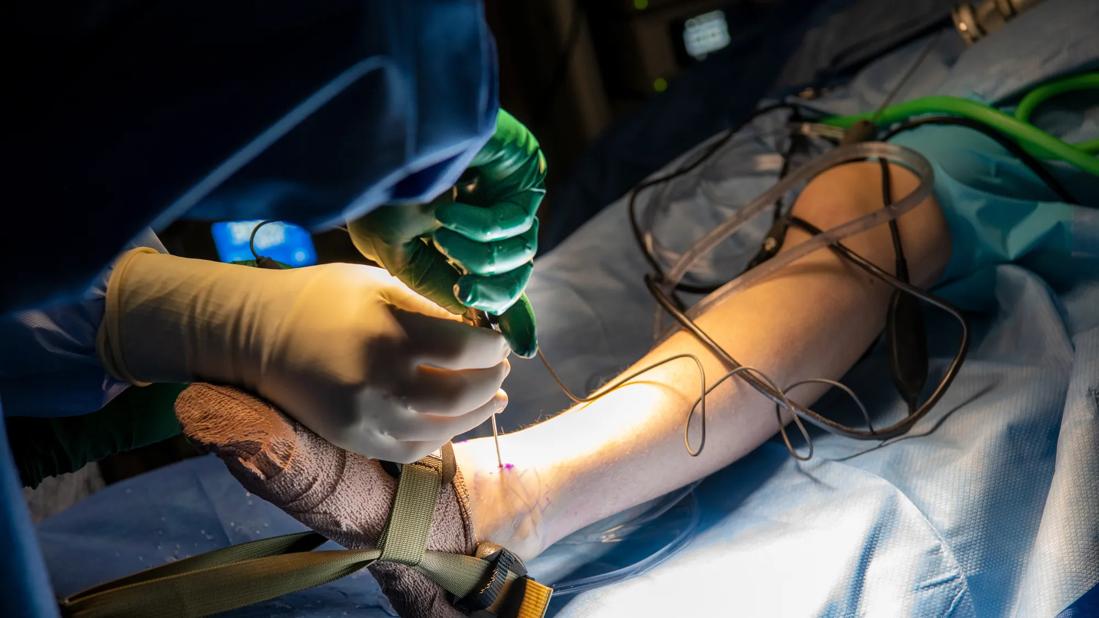Cleveland Clinic’s Adult Reconstruction Research leaders share what they’ve learned over 16 years

When Cleveland Clinic’s Adult Reconstruction Research (CCARR) Program began in 2007, it was a rare entity, the brainchild of former Cleveland Clinic orthopaedic surgeon Wael Barsoum, MD. Alison Klika, then doing orthopaedic bench research in Cleveland Clinic’s Lerner Research Institute, remembers the beginning.
Advertisement
Cleveland Clinic is a non-profit academic medical center. Advertising on our site helps support our mission. We do not endorse non-Cleveland Clinic products or services. Policy
“Dr. Barsoum had a vision for a unique clinical research program, but he needed to build a team,” she says. “He had a small bit of corporate money and one resident, James Rosneck, MD, now staff at Cleveland Clinic Sports Medicine Center and team physician for the Cleveland Cavaliers. Dr. Rosneck conducted joint reconstruction research as part of his training. Dr. Barsoum needed someone with writing and publishing experience, so he brought me in. It was initially just the three of us. I didn’t even have a job title.”
Klika, now the program manager, has seen the research group grow over the past 16 years.
“Back then, I was writing grants, submitting proposals for corporate funding, conducting research, analyzing the stats and whatever else was needed,” she says. “Now there are nearly a dozen of us who specialize in different functions. Our group has become a machine. We’ve gone from publishing five or 10 manuscripts a year, if we were lucky, to publishing more than 100 in 2022.”
The current CCARR team includes a basic and translational lead scientist, three research coordinators, a data analyst, two research fellows (with a two-year commitment) and multiple medical students (with a one-year commitment), all led since 2018 by Director Nicolas S. Piuzzi, MD, of Cleveland Clinic’s Department of Orthopaedic Surgery.
“We have 10-15 prospective clinical trials in progress at any given time — including leading large multicenter studies — in addition to conducting multiple retrospective research and other studies,” says Dr. Piuzzi. “Our vision to advance personalized patient care through evidence-based orthopaedic practice has led us to collaborate with most major orthopaedic centers in the U.S. and around the world.”
Advertisement
In this interview, Dr. Piuzzi and Klika explain more about the structure of their group and offer guidance for orthopaedic surgeons interested in building clinical research programs of their own.
Dr. Piuzzi: Cleveland Clinic has one of the broadest practices in joint replacement, with numerous providers and partners in a high-volume, high-complexity environment. Add to that a team dedicated solely to advancing joint arthroplasty through research. That combination is exceptional.
Our uniqueness, however, is our team structure, which has been evolving and maturing over more than a decade. Many CCARR team members have been added and have become more proficient in each step of the research process. All of us have a shared mission: to improve the outcomes of hip and knee arthroplasty patients through personalized medicine and evidence-based orthopaedic surgery. That mission is why we have invested resources in training residents and research fellows; embedded a data analyst in our group; and recruited a PhD to lead our basic and translational research projects, including developing an animal model for studying biofilm and infection prevention.
Klika: We build relationships outside of our group as well, such as with biostatisticians, legal experts and clinical partners who refer patients for trials. Most of our funding comes from corporate relationships. The fact that we’ve been able to build this effort out of corporate funding, as well as some philanthropic support and foundation grants, and maintain it for 16 years is also unique.
Advertisement
Dr. Piuzzi: This problem is not unique to orthopaedic surgery. It applies to most surgical subspecialties. Randomized controlled trials, which can provide the best evidence of the value of an intervention, are challenging to execute in a surgical environment. Blinding surgeons and surgical patients is nearly impossible, providing sham surgeries for a control group is unethical, and the logistics of randomized controlled trials are complex.
While many surgical interventions are already proven by empirical evidence or just the proof of time, there are many things for which we don’t have good evidence. There are gaps in our treatment protocols for certain conditions or disease stages.
Our goal in CCARR is to identify an evidence-based approach for each of these gaps. For example, we have a big gap with infection, so we need to create a strategic focus area within our program to answer questions about infection. We have a gap in understanding patients who have complications or do not improve after joint replacement, so we need to create a strategic focus area for personalized medicine to optimize patients and tailor treatments for them. We have a challenge in revision arthroplasty, in creating stable and long-lasting implants that can survive years and years after multiple revision surgeries. We need to create a strategic focus area to study that.
Gaps like these are why we need more orthopaedic research and more groups to do it.
Dr. Piuzzi: Yes, but not just large prospective trials. We need more research of all kinds. For example, if we wanted to study joint replacement in patients with a left ventricular assist device due to heart failure, it would be extremely hard to do a randomized controlled trial because there are so few patients in the world who would qualify for it. We couldn’t recruit enough patients in a reasonable amount of time. In that scenario, the best available data might come from a retrospective case series or cohort.
Advertisement
For even more unique scenarios, a case study might provide great value.
Randomized controlled trials and systematic reviews of those trials are the strongest scientific evidence you can get, but each type of research provides value.
Not every orthopaedic surgeon or practice has the resources to conduct the breadth of research that we do. But everybody could have some level of involvement in different tiers of research, contributing in some way to our field. Having an open-minded, question-driven approach makes everyone’s clinical practice better.
Dr. Piuzzi: Our work has a direct and positive impact on Cleveland Clinic patients — and hopefully patients around the world. We use our research findings to create models and tools that we test and validate not just for ourselves but for the entire field.
One great example is the predictive modeling that we have developed based on collected patient data, such as mental health status. We can predict how long a patient will stay in the hospital, their chance of being discharged to a skilled nursing facility rather than home, and their chance of being readmitted within 30 or 90 days. We have personalized risk profiles that guide how we take care of each patient. If we identify high risk in someone, we recommend resources to help reduce it.
Klika: The work of our research team is what made those models possible, in collaboration with our clinical partners, programmers and electronic medical record specialists. We don’t just publish the research; we incorporate it into our clinical workflows. Another example is our partnership with Cleveland Clinic’s rehabilitation programs that aid post-acute care transitions after total joint arthroplasty. Those transitions were developed with support from our research, guiding discharge disposition after surgery. Data collected by our group provides a starting point for conversations with all kinds of patient care teams.
Advertisement
Dr. Piuzzi: In April 2021, we published an overview in EFORT Open Reviews of how to build a “team that lasts” in orthopaedic clinical research. There are seven main takeaways from that article:
We provide more guidance on all these elements in the full article. To sum it up, successful programs start with one surgeon committed to advancing orthopaedics through research, who is willing to share that vision with others and build a team to make that vision a reality. It takes a team.
Advertisement

How chiropractors can reduce unnecessary imaging, lower costs and ease the burden on primary care clinicians

Multidisciplinary care can make arthroplasty a safe option even for patients with low ejection fraction

Dr. Piuzzi wins 2025 Kappa Delta Young Investigator Award for pioneering work

Fellows’ research shows quality of arthroplasty training

Networking, focused planning may be keys to success

Initiative recognizes excellence, strengthens alumni engagement

Sinus tracts can occur years later and not near the incision site

New phase 1 trial showcases Neurological Institute’s interdisciplinary study capabilities